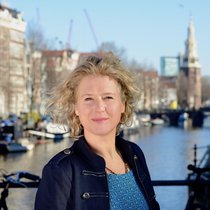But which ones should take priority? And which quaysides are still in good condition? Research by AMS Institute and TU Delft, conducted in collaboration with the City of Amsterdam, has resulted in a new model that provides insight into the construction, load, and failure of Amsterdam's quaysides. Mart-Jan Hemel defended his thesis on this at TU Delft on November 30.
Built on wooden piles within a basin of soft peat-clay subsoil, Amsterdam has traditionally required continuous maintenance, particularly for its quaysides. The 205 km of quayside structures in the city are supported meters below the water surface by a historic wooden framework — a kind of 'wooden table construction,' as described by Mart-Jan Hemel. If something goes wrong with that construction, a so-called failure mechanism, the risk of collapse is imminent. 'Within a few minutes, twenty meters of quayside can just disappear into the canal,' says Hemel. The most common and serious failure mechanism observed in the center of Amsterdam is the horizontal failure of the foundation, as observed in the infamous Grimburgwal collapse of 2020.
Insight into Failure Mechanism
To gain a thorough understanding of the failure mechanism of historical quaysides, Hemel, along with a large team of partners, executed a unique experimental program on an existing historic quay, supported by wooden piles. The specific quay in Amsterdam Overamstel dates back to 1905. Using sensors and applying various loads to the quaysides, the Delft researcher mapped out how the failure of pile foundations unfolds. Subsequently, he developed a computational model to precisely predict which quaysides are at risk of failure. Hemel demonstrates that horizontal failure is most likely to occur when a quayside at the back is loaded at ground level (such as the sidewalk or road). Practical examples of such loads include parked or moving cars, heavy vehicles, or goods/building materials. The model is 40% more accurate in identifying quaysides at risk of failure than previous models.
“Existing models for calculating the resistance of quaysides against such failure mechanisms offer limited information on strength and safety, potentially leading to premature labeling of quays as 'unsafe.' In reality, many structures deemed unsafe on paper perform quite well. With this model, we can more precisely assess the strength of quaysides”
Mart-Jan Hemel
Former Research Fellow at AMS Institute

Crucial Insights for Policy
The new insights provide the city with crucial knowledge to enhance control over the safety of quaysides and support decisions regarding safe usage, remaining lifespan, and the necessity for replacement. The research is not only relevant for Amsterdam; the Netherlands has 1700 km of historical quayside. For cities like Delft and Leiden, as well as internationally in Venice and Boston (USA), quays built on wood and their sustainability and preservation are significant points of concern.
“Our beautiful urban spaces face a monumental task of replacement due to aging, altered use from their original purpose, and the effects of climate change. With this research in this unique collaboration at AMS Institute, Delft researcher Mart-Jan Hemel sets entirely new standards that directly benefit practical applications. Call it literally applied science, it is a phenomenal result”
Sacha Stolp
Director of innovation
AMS Institute's Comprehensive Collaboration Crucial for Research Results
The research results stem from a close collaboration between academia and urban practice, with a clear focus on developing practical solutions for societal issues. Mart-Jan says, 'In the face of such complex challenges, conventional methodologies and monodisciplinary analyses fall short.' He believes that structural collaboration among stakeholders is essential. 'For me, AMS Institute is the perfect infrastructure where diverse stakeholders from the realms of knowledge, industry, and government come together to tackle significant technical challenges in the city, driven by impact. In our case, this included various engineering firms, the municipality, and researchers from TU Delft.'
Partners involved in the research:
